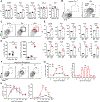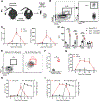Circulating T follicular helper cells are a biomarker of humoral alloreactivity and predict donor-specific antibody formation after transplantation
- PMID: 31250973
- PMCID: PMC7193899
- DOI: 10.1111/ajt.15517
Circulating T follicular helper cells are a biomarker of humoral alloreactivity and predict donor-specific antibody formation after transplantation
Abstract
Donor-specific antibodies (DSAs) contribute to renal allograft loss. However, biomarkers to guide clinical management of DSA posttransplant or detect humoral alloimmune responses before alloantibodies develop are not available. Circulating T follicular helper (cTfh) cells are CD4+ CXCR5+ Tfh-like cells in the blood that have been associated with alloantibodies in transplant recipients, but whether they precede antibody formation for their evaluation as a predictive biomarker in transplant is unknown. To evaluate the ability of cTfh cells to predict DSA, we used murine transplant models to determine the temporal relationship between cTfh cells, germinal center formation, and DSA development. We observed that donor-reactive CD4+ CXCR5+ cTfh cells expand after allotransplant. These cTfh cells were equivalent to graft-draining lymph node-derived Tfh cells in their ability to provide B cell help for antibody production. cTfh cell expansion and differentiation into ICOS+ PD-1+ cells temporally correlated with germinal center alloreactivity and preceded the generation of DSAs in instances of modified and unmodified alloantibody formation. Importantly, delayed costimulation blockade initiated after the detection of ICOS+ PD-1+ cTfh cells prevented DSAs. These findings suggest that cTfh cells could serve as a biomarker for humoral alloreactivity before the detection of alloantibodies and inform therapeutic approaches to prevent DSAs.
Keywords: T cell biology; alloantibody; basic (laboratory) research/science; biomarker; costimulation; immune; immunobiology; immunosuppression/immune modulation; monitoring; translational research/science.
© 2019 The American Society of Transplantation and the American Society of Transplant Surgeons.
Conflict of interest statement
Disclosures
The authors of this manuscript have no conflicts of interest to disclose as described by the
Figures







References
-
- Nankivell BJ, Borrows RJ, Fung CL, O’Connell PJ, Allen RD, Chapman JR. The natural history of chronic allograft nephropathy. N Engl J Med. 2003;349(24):2326–33. - PubMed
-
- Loupy A, Hill GS, Jordan SC. The impact of donor-specific anti-HLA antibodies on late kidney allograft failure. Nat Rev Nephrol. 2012;8(6):348–57. - PubMed
-
- Wiebe C, Gibson IW, Blydt-Hansen TD, Karpinski M, Ho J, Storsley LJ, et al. Evolution and clinical pathologic correlations of de novo donor-specific HLA antibody post kidney transplant. Am J Transplant. 2012;12(5):1157–67. - PubMed
Publication types
MeSH terms
Substances
Grants and funding
LinkOut - more resources
Full Text Sources
Medical
Research Materials

